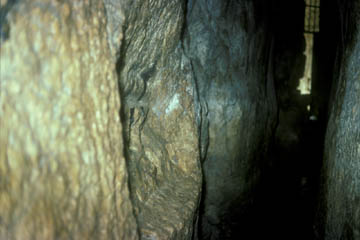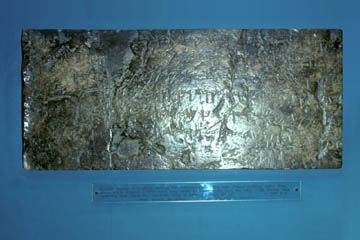Almost Home!
It's something that has long needed doing and I'm glad to report that it has finally been done - the Hezekiah's Tunnel inscription has come home.

|
| The hole in the wall of Hezekiah's Tunnel from which the Siloam Inscription was hacked. The exit from the tunnel can be seen in the background. |
In 1880 two boys were playing in the Pool of Siloam when one of them ventured into the dark mouth of the Siloam Tunnel that had recently been explored by the Englishman, Charles Warren. About twenty feet in he tripped on a loose stone and fell into the water, sending up a mighty splash that deluged the wall above him. When he turned to rejoin his companion he noticed faint markings on the wet wall which, highlighted by the faint gleam from the tunnel exit, appeared to be writing.
Later on that day he mentioned his discovery to his tutor, the German Conrad Schick, who hastened down to the tunnel with a light and confirmed that there was indeed writing on the tunnel wall that had been unnoticed by any of the previous explorers of the tunnel. Schick, however, was unable to read the inscription and it was left to the Oxford scholar, A. H. Sayce, to decipher it. He draw a copy of the inscription, working by candelight and sitting in the cold water for hours.
The following year Hermann Guthe made a plaster cast of the inscription and, finding that the letters were partially filled in and obscured by deposits of lime, he sent off to Europe for some hydrochloric acid. Dilute applications of the acid dissolved the lime and made it possible to take several much more accurate squeezes and casts of the inscription.
It was as well that they had done so, for in 1890 the inscription disappeared, leaving a gaping hole in the rock. No one knew who had done it - and the identity of the culprit is still a mystery, but several months later it was discovered in the store room of a Greek antiquities dealer, who claimed to have bought it for 35 napoleons from an Arab whose name he could not remember.
Unfortunately, whoever had done the actual chiselling out had been extremely unskilful and the inscription was broken into some six or seven pieces, so that were it not for the casts, the inscription would have even more gaps in it than is in fact the case. The Turkish government promptly confiscated the remains and transferred them to Istanbul, where they remain in the Archaeological Museum.

|
| A plaster cast of the Siloam Inscription, formerly in the British Museum, now relegated to a storeroom somewhere. |
This is the story of the boring through. While [the tunnelers lifted] the pick-axe each toward his fellow and while three cubits [yet remained] to be bored, [there was heard] the voice of a man calling his fellow – for there was a crack in the rock on the right hand. When the tunnel was driven through, the tunnelers hewed the rock, each man toward his fellow, pick-axe against pick-axe. And the water flowed from the spring toward the reservoir for twelve hundred cubits. The height of the rock above the head of the tunnelers was a hundred cubits.
A trip through the Siloam Tunnel is one of the many highlights of the Diggings Tour and although we have to walk in single-file through the tunnel, I always wait near the exit to point out, as each person passes it, the hole in the rock from which the inscription came. Unfortunately, it can be hard to visualise photographs of the inscription fitting into that shallow hole, so I was delighted on my visit to Jerusalem this year (2009) to discover that a reproduction of the inscription is now fixed to the wall beside the hole.
Approaches have been made by the Israeli government to the Turks for a return of the inscription. Rightly, the Turks have rejected the idea - I am against Museums giving up their treasures and dispersing them around the world from which they came - but I wish they would put this important piece of ancient history on display, along with all the other treasures on those upper floors.
Charles Warren A British army engineer, Charles Warren was the pioneer of archaeology in Jerusalem. Finding it impossible to obtain permission to excavate, he applied to the Turkish authorities for permission to dig a well. Seeing no harm in his request, the permission was duly granted and Warren promptly dug his "well" right next to some feature he wished to explore.
Once safely below ground and out of sight of the Turks, Warren began to dig tunnels in all directions, exploring the extent of the Wailing Wall and making many interesting discoveries. Further "wells" followed, based on his lack of success in finding water in the first! When Kathleen Kenyon excavated in Jerusalem, she kept finding the old shafts dug by Warren and was astonished at the smallness of those tunnels - clearly he didn't suffer from claustrophobia!
Similar bravery - or foolhardiness, if you prefer - was shown by Warren's exploration of the Siloam Tunnel in October 1867. It was known that the Gihon Spring was intermittent and would, unpredictably, gush with water far in excess of its normal flow. As the Siloam Tunnel would suddenly flood about half an hour later it was suspected that the two were connected, but the only people to have proved a connection were two reverend gentlemen, Edward Robinson and Eli Smith, who explored the tunnel in April 1838. Warren was either unaware of their exploit or wished to make a more thorough investigation.
The first part of the tunnel was fine, for at the Siloam end it is a good 30' or more in height, and despite the stones and rubbel that had been washed down the tunnel, he was able to walk along. After a while, however, he had to stoop and then crawl. In the end he was lying on his back, candle clutched in his teeth, his nose barely above the water and the tunnel roof a bare 4 inches above his nose, pushing himself along with his feet an inch at a time, never knowing when the Gihon Spring would suddenly gush and drown him.
Eventually, of course, he came to the spring and was able to stand up again, having triumphantly proved the connection between the two. He was accompanied by Sergeant Birtles, his colleague and clearly just as courageous and as lunatic. Return
Archaeological Museum Unfortunately they are located on the upper floors of the museum, which are only open to the public when the moon is blue. In all my many visits to Istanbul, I have only been on the first floor twice and the second floor once, which is a disgrace and the Turks should be thoroughly ashamed of themselves.
I once took a class in archaeology from the American archaeologist Siegfried Horn and he claimed that many years previously he had visited the Istanbul Museum in search of the Siloam Inscription, only to be told by the museum authorities that there was no such object in their collection. Horn protested that he knew for a fact that it had been brought to Istanbul and as this was shortly after the second World War and the Turks were eager to keep in good with their American allies, he was permitted to wander around the museum storerooms.
After considerable searching he finally went out into a yard and spotted the inscription, whose shape he knew well from photographs. When he pointed it out to them, the museum staff were astonished and told him that they had not known what it was and might have thrown it out as unprovenanced rubbish had he not come along.
To what extent they were telling the truth rather than simply flattering their distinguished visitor, I cannot tell, but given Turkish incompetance in keeping the museum open, nothing would surprise me. Return
important piece Annoyingly, the British Museum has also removed its copy of the Siloam Inscription, which used to stand in pride of place in one of the upper galleries. I suppose they feel that with limited space they should give priority to genuine artefacts rather than mere copies, but the inscription is so important that it deserves to be shown rather than a couple of old pots, no matter how genuine. Return
© Kendall K. Down 2009





